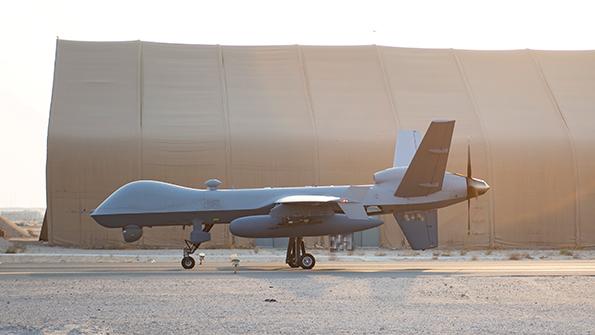How Effective Can ‘Over the Horizon’ Operations Be in Afghanistan?

A U.S. Air Force General Atomics MQ-9 Reaper took off from a Persian Gulf base on Aug. 27 for an extended-range mission to Afghanistan’s far east, a strike that served both as retribution for a massive suicide bombing the day before in Kabul and a demonstration of how the Pentagon will conduct operations in the country without forces on the ground.
This MQ-9, a modified version with an external fuel tank and longer wings, fired its weapon at what U.S. Central Command said was a “planner” for the group known as Islamic State Khorasan (ISIS-K) in Nangarhar province near the Pakistan border.
For weeks before the chaotic drawdown, Pentagon officials maintained the U.S. military had an extensive capability to conduct “over the horizon” counterterrorism strikes on Islamic State group and al-Qaida targets in Afghanistan, even with no U.S. intelligence presence on the ground. The strike demonstrated U.S. drones can still loiter in Afghan skies and hit key targets, to put ISIS-K on notice and reassure the U.S. public. However, maintaining that capability will not be easy.
“[Over the horizon] strikes are never easy operations, since they require close coordination across multiple sensor and command-and-control assets,” says U.S. Air Force Col. (ret.) Mark Gunzinger, director of future concepts and capability assessments at the Mitchell Institute for Aerospace Studies. “Successfully ‘closing the kill chain’ and doing so with great accuracy and avoiding unwanted collateral damage is further complicated when targets are highly mobile [and] change locations frequently.”
- Specialized MQ-9s have conducted strikes in Afghanistan
- Lack of ground forces raises civilian casualty concerns
In recent years, U.S. forces have been able to overcome those challenges. The issue of long-range strikes played out two days after the Nangarhar strike. On Aug. 29, an MQ-9 made the long flight from the Persian Gulf to Kabul, where surveillance showed what U.S. forces believed was ISIS-K preparing a car bomb to attack the Kabul airport.
The MQ-9 fired one missile at the target in a populated area. The strike destroyed the car, and then there was a secondary explosion—a sign that other explosives were there.
“We had very good intelligence that ISIS-K was preparing a specific type vehicle at a specific type location,” Gen. Mark Milley, Joint Chiefs of Staff chairman, said Sept. 1. “We went through the same level of rigor that we’ve done for years, and we took a strike.”
Immediately after the strike, reports on the ground began to indicate civilian casualties. A preliminary analysis, obtained by The New York Times, reported that the Reaper operator made the decision to fire on the car when it was in a secluded area, but additional people emerged after the Hellfire missile was released.
“So were there others killed? Yes,” Milley said. “But we believe that the procedures . . . were correctly followed, and it was a righteous strike.”
The Aug. 29 airstrike took place when some U.S. forces were still on the ground and with aircraft monitoring the area and intercepting communications. After the withdrawal, fewer assets are available to collect such information. “Big Wing” intelligence, surveillance and reconnaissance aircraft such as the Air Force’s Northrop Grumman E-8 and Boeing RC-135 and associated tanker support are not expected to be part of a regular air tasking order to Afghanistan.
Extended-range MQ-9s from the Persian Gulf, and possibly larger Northrop Grumman R-4 Global Hawks, will track targets in Afghanistan. These aircraft can feed information into extensive artificial-intelligence capabilities, such as the nascent Project Maven analysis effort to help the targeting process, says Bryan Clark, a senior fellow at the Hudson Institute.
“New intelligence processing capabilities, including those [artificial intelligence]-enabled algorithms, are enabling U.S. commanders to track patterns of life and improve their ability to engage targets using [remotely piloted aircraft] when the targets are isolated,” he says.
Air Force Chief of Staff Gen. Charles Q. Brown, Jr., said Sept. 8 that the Air Force and U.S. Central Command will need to become more strategic in intelligence, surveillance, and reconnaissance over Afghanistan, shifting to a “broader look for indications and warnings of what might occur” beyond just monitoring individuals. This would include both aircraft and U.S. Space Force space-based assets.
Throughout the Kabul airlift, Air Force F-15s, F-16s, B-52s and U.S. Navy F/A-18s provided overwatch to protect U.S. forces on the ground. With the Air Force unlikely to devote its tankers to Afghanistan, the carrier-based fighters can provide faster strike support. This, however, would require the Navy to keep a carrier off the coast of Pakistan instead of in higher-priority theaters, Clark says. All aircraft will need to rely on the “boulevard” of airspace through Pakistan for operations in Afghanistan, and both the State Department and the Pentagon expect that support to continue.
To help with intelligence, Milley and Defense Secretary Lloyd Austin left the door open to an unlikely collaboration following the U.S. withdrawal: working with the Taliban.
“It’s possible,” Milley said.
“I would not want to make any predictions,” Austin added. “I would tell you that we’re going to do everything that we can to make sure we remain focused on ISIS-K, understand that network, and at the time of our choosing in the future, hold them accountable for what they’ve done.”






Comments